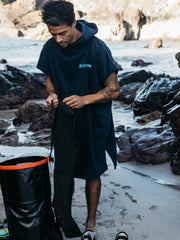In 2013, some years after his first and, at that time, only encounter with a thresher shark, SeaLegacy co-founder Shawn Heinrichs travelled to Alor, Indonesia, to find out how a once minimal impact shark-fishing practice had taken such a drastic turn for the worse.
“I was a guest with those fishers, and we went puttering out into a channel of deep water with raging currents,” Heinrichs explains. “The fishermen dropped handlines into the water with these elaborate lures at the end that are designed to look like schools of juvenile anchovy – thresher sharks stun them by whipping their tails while hunting. The lines went down and down, to around 200 metres. The line went taught and I watched as these guys hauled it up with their bare hands, pull by pull, as if it weighed nothing. Eventually, a beautiful three-metre thresher shark emerges from the water, the lure wrapped around its long tail.”
After arriving back at the beach and watching more boats loaded with sharks arrive, Heinrichs had to take a moment to reset and remember that this was a fishing community – this was their livelihood. But when he saw a man with a machete moving along the row of carcases removing the fins, he knew something was wrong.
Heinrichs later met with the village elders who acknowledged that catch success had declined in recent years, which had pushed them to targeting thresher sharks. A fin trader had come to Alor and told the elders he would pay them for shark fins, and so began the commercial sale of fins. It is a story that repeats itself around the world. Local communities that go from having a small group of hunters who occasionally catch a shark to a targeted operation where hundreds of sharks are landed each season.






























































































